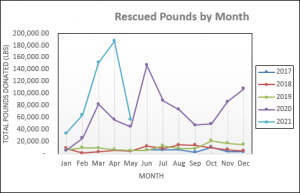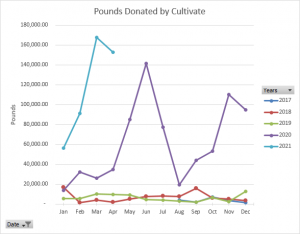I first met Jim Conklin and Todd Zeltwanger in 2019. We met at the kitchen of an old mental-health facility, where they set up operations for their burgeoning nonprofit Cultivate. The pair was just coming off a dizzying frenzy of media attention highlighting their work. Although they’d just spent a week or two sitting for national television interviews and fielding calls from others hoping to copycat their success, I couldn’t tell. Jim and Todd were buzzing with passion for feeding hungry kids.
Cultivate’s mission isn’t complicated. It rescues food that would otherwise be thrown away from places like convention centers, college football concession stands, and gatherings serving a buffet. Cultivate repackages the food into single-serving meals and freezes it. Once a week, six frozen meals are placed into book bags and sent home with low-income kids who may not have access to food over the weekend.
But how does that work during a pandemic? If you’re Cultivate, you go even bigger.
The nonprofit had just moved from the old facility into a new 11,000-square-foot building when the pandemic hit. I recently had an opportunity to tour the facility and it was an incredible upgrade. It has two massive walk-in freezers, two commercial kitchens, and a large space perfectly set up for volunteers to package those individual meals.
All that extra space supported Cultivate’s mission in a time when it was needed more than ever. Sporting events and large gatherings were shut down, which cut into the food available for rescue. But restaurants were also closed, and it wasn’t long before they started calling Cultivate to take that uncooked food. Luckily, it had that brand new commercial kitchen ready to go.
In total, Cultivate rescued over 1 million pounds of food from March 2020 through March 2021. It produced about 5,000 meals a week.

Of course, reaching hungry students looked different when schools are closed. During my tour, I asked Todd how they adapted. He told me Cultivate volunteers either dropped meals at the schools for students to pick up, or they made home delivery. More than 800 students received a backpack each week throughout the pandemic.
But it’s not just about kids. Cultivate also supplied meals to food pantries, veterans, and hospitals. Their distribution increased by 439 percent from the previous year.
The pandemic also changed how like-minded community organizations collaborated. Todd attends a weekly phone call with many food-related nonprofits in the area. The conversation usually focuses on where the need is greatest, and who has food to spare. In a time when the virus has made so much work more difficult, it provided the perfect reason to get everyone talking.

Unfortunately, there are still people — including school-aged kids — who are food insecure. So while it’s astounding to see how Cultivate adapted and thrived during the pandemic, the mission isn’t accomplished. Todd shared a heart-wrenching story from a local elementary school. He said normally the students aren’t allowed to run in the building. Except on Monday morning. That’s when they let the kids run to the cafeteria. For too many, it’s the first meal they’ve had since Friday’s lunch.
For more information about Cultivate, you can visit their website. If you’re ready to help, you can also make an online donation.
Amanda Zaluckyj blogs under the name The Farmer’s Daughter USA. Her goal is to promote farmers and tackle the misinformation swirling around the U.S. food industry.



